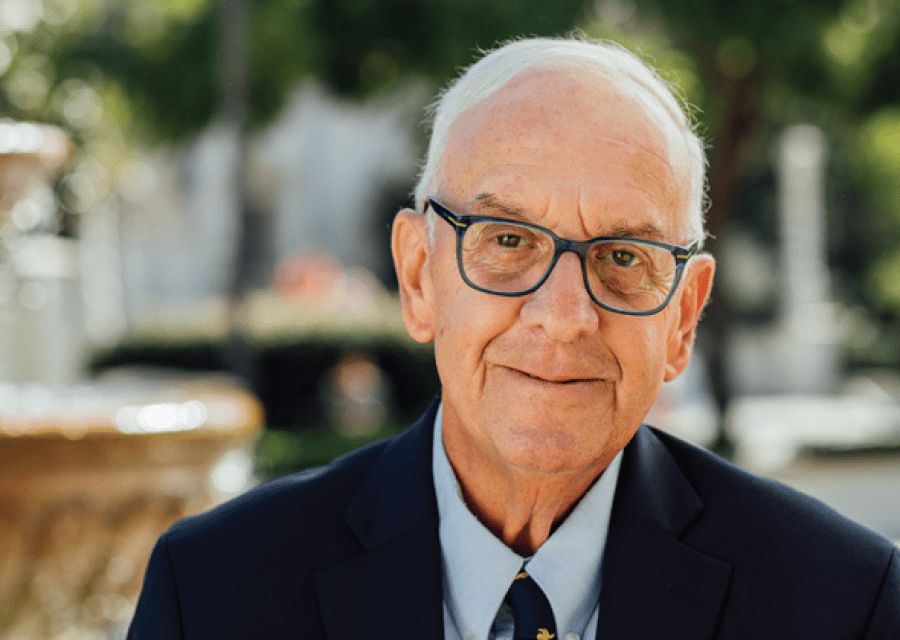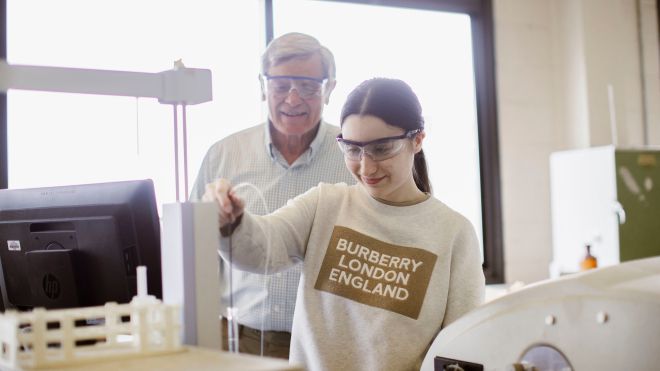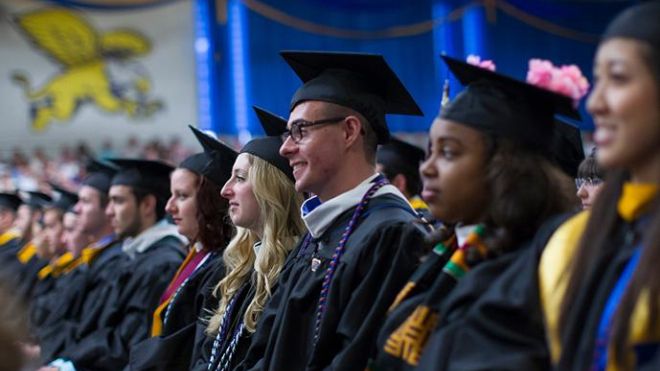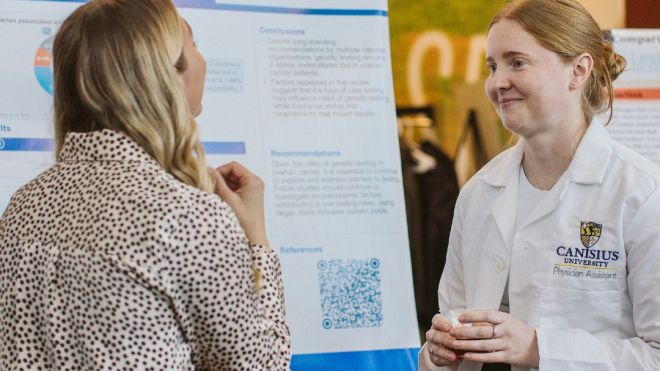
“I have always believed in giving back, using my time, talent and treasure to assist others. I began giving back to Canisius at the start of my college teaching career. With five children in eight years, we could not afford much but the appeal to ‘give something’ resonated with me. I began small – knowing that every little bit helps the continuation of the excellent education I received at Canisius. At my 50th reunion in 2012, I was able to pledge a more substantial amount over a five-year period and know that many of my classmates were able and willing to do the same. It’s my hope that every graduate will also start to contribute soon after graduation so the college may continue its mission of educating men and women who serve the community and beyond.”
Dr. Infantino is a professor emeritus of education at the University of San Diego. Below, he talks more about his life and the influence Canisius has had on him.
I have been married to Virginia (Ginger) Pinto Infantino for 55 years. We have six children, 10 grandchildren and one great grandchild, born in July 2017. Ginger was San Diego Diocesan Director of the Office of Evangelization and Catechetical Ministry for more than 20 years and worked for the Catholic Diocese for more than 28 years. Five of our six children are educators, and one grandchild and her husband are also teachers. All the children are involved in ministry in the Church here, in Virginia and in Hawaii.
I started at the University of San Diego (USD) in 1976 as an Assistant Professor/Director of Teacher Education, was promoted in 1980 to associate professor and in 1991 to full professor. Upon my retirement in 2007, USD named me Professor of Education, Emeritus.
Prior to USD, I was an English teacher at East High School and Lafayette High School (seven years) in Buffalo, NY. In 1971, I was awarded a scholarship grant to attend the University of Buffalo as a doctoral student and supervisor of student teachers. After two years, I was named Assistant Professor/Coordinator of Student Teaching at UB while completing my doctorate in English education. I received the Doctor of Education (Ed D) in August of 1976 and was hired at the University of San Diego.
USD is a Catholic University founded in 1949 by the San Diego Catholic Diocese and the Religious of the Sacred Heart (RSCJ) as separate Men’s and Women’s Colleges on the same campus. The two merged into one University in 1972. USD reminds me a lot of Canisius University, with small classes and personal attention, though it has a Law School and about 10,000 total students. It was recently named one of the top 10 most beautiful campuses in the USA.
During the time I was actively teaching in San Diego, I accepted several leadership positions in education and received several commendations for my service:
a. Board member and President of the Greater San Diego Council of Teachers of English. Received the Outstanding Service Award.
b. Served as Co-Director of the San Diego Area Writing Project, 1980-1991. This is a site of the National Writing Project, and is based at the University of California San Diego (UCSD). I advised Dr. Lauerman at Canisius on starting a site at the College.
c. President of the California Association of Teachers of English (CATE) 1994-96. Served on its Board from 1985-1998. Received the Distinguished Service Award in 1999 from CATE.
d. Member of the California Council on Teacher Education (CCTE) continuously since 1976. Its membership includes public and private universities from throughout California, as well as individuals and organizations involved with the education of teachers. I was named by the organization in 2011 as the statewide Distinguished Teacher Educator.
e. Received a University Professorship from the University of San Diego in 1996. This cash and release time award enabled me to travel to Europe for the first time. I was able to incorporate what I saw and learned into my course teaching, which enhanced the Catholic Identity goals of USD.
In 1983, a colleague and I published a book entitled Real World Reading Activities for Teachers and Students (De Roche, E. and Infantino, R. (1983). Springfield, Illinois: Charles C. Thomas, Publishers). It is a very practical book, especially for younger teachers.
I co-wrote a second book, incorporating some of my Canisius philosophy minor. The book is called Tough Choices for Teachers: Ethical Challenges in Today’s Schools and Classrooms. (Infantino, R. and Wilke, R. 2009. Lanham, Md.: Roman and Littlefield, Publishers). This book of ethical theory and decision-making case studies grew out of a team taught course on ethics and education. The co-teacher, Loyola of Chicago graduate Dr. Larry Hinman, and I were part of an interdisciplinary program for teaching required ethics courses for undergrads. We taught our course10 times over 20 years and tried out many of the book’s cases with the students. Ethics was one of the courses for which I can thank Canisius for including in my program in the 1960’s.
Another written piece grew out of 20 years of attending and maintaining continuing interest in Catholic schools from K-college. It is called “Should we open a new [Catholic] school?” Published in 1982. (DeRoche, E., Infantino, R., and Rost, J. Momentum. National Catholic Education Association). Ed DeRoche was Dean of the School of Education and is Director of the Character Education Center at USD, and Joe Rost was a former Christian Brother and a School Superintendent, before he began at USD in 1976. His book, Leadership in the 21st Century, is still a defining book on Leadership Studies.
It was fortuitous for me to meet up with the Jesuits when I was 13 years old. My grandfather was a “Barber to the Jesuits” who lived at St. Michael’s parish in downtown Buffalo, the original site of Canisius University. He opened his shop on Tupper Street and ran a tab for the Jesuits from 1924 until he retired in 1978. I think he forgave some of their debts when I started at Canisius High in 1954. The transition to the college was easy for me and for many of my high school classmates, since some of us could not afford to go out of town for school. But more than that, we learned so much at CHS and wanted to continue learning in a Jesuit, Catholic environment. I was not disappointed. The college was a perfect fit for what I wanted to do – become an English teacher just like Mr. Robert Barth, S ., my 12th grade Jesuit scholastic motivator. (More on him later.)
I received a partial scholarship to Canisius High for finishing in the top 50 on the entrance exam. The college also offered a half scholarship for my first year. It really helped because my dad, a steelworker, crushed his heel in a plant accident in 1958 and could no longer work at that job. Tuition was only about $100 a semester at that time but every little bit helped. I worked throughout college to help pay tuition costs. Remember that $1.00 per hour was the prevailing wage.
There is no doubt that Fr. Robert Barth, S J, had the most influence on me. He was in Jesuit training in 1958 when he served as my English teacher at CHS. But he was more than that. He was a mentor, a fun loving spirit and a motivator of excellence. When I started college in September, I was asked what I wanted to be. At age 17, I wrote that I wanted to become an English teacher (just like Mr. Barth, I thought to myself). After graduation from the college in 1962, and after military service and the start of my teaching career, I re-entered Canisius for my masters in English education. By some magic, who showed up for my last class but Fr. Robert Barth, SJ, who had spent the past four years earning his doctorate from Harvard and a post-doc fellowship on Samuel Taylor Coleridge at the Sorbonne in France. We hugged at that first class at 9 a.m. on a Saturday in September and truly enjoyed each other’s company for a whole semester. The 15 other students wondered what was going on between us two. No doubt this Jesuit mentor has a devotee for life. His distinguished career took him to Boston College until his life ended much too soon. He knows now that at least one of his students regularly remembers his influence and has tried to emulate him throughout a 43-year career of carrying on his work.
Many of my family and friends would tell you that at Canisius University I majored in Glee Club, minored in ROTC and received a degree in English. Singing and serving as an officer in the Glee Club under Robert Shultz provided a continuing opportunity for exercising the music skills I had developed throughout my life – piano lessons at age eight, singing in elementary and high school, and singing in a Latin/German parish choir at St. Gerard’s with my future wife. I have continued with music, singing with the community choir at USD and volunteering to lead a contemporary church choir at our parish for the past 30 years, singing and playing piano or guitar every week. Ginger and I occasionally sing together for groups such at the “Seniors Lunch Bunch” at our parish and at other gatherings in senior living centers, and at education functions.
Canisius ROTC offered more opportunities for leadership through my participation on the award-winning Drill Team and becoming a cadet officer as a senior. I was offered a regular Army commission at graduation but decided to train as a military police officer at Ft. Gordon, GA. I was sent to the JFK Center for Special Warfare at Ft. Bragg as an intelligence officer, with responsibilities for researching and writing “propaganda” for our areas of responsibility in the world. The English major really helped. Active service in 1962-64 included the Cuban Missile Crisis, in a Psy.War unit that was prepared to back up the Special Forces for an invasion of Cuba. Fortunately we did not have to engage but the mission was clear. The years at Ft. Bragg included the assassination of President Kennedy in November 1963, one of the saddest days of my life.
After I started teaching in 1964, I joined a Military Police National Guard unit training at the Connecticut St. Armory in Buffalo. Four summers at Camp Drum included the 1967 Civil Rights protests. I was told that we might have to assist in enforcing the laws, which included enforcement in the neighborhoods where my high school students and their families were living. Speaking of ethical choices. But Buffalo was able to overcome the protests rather peaceably.
Among community activities using Jesuit principles were service on the Advisory Council of the Ignatian Volunteer Corps (IVC), a group dedicated to placing professional volunteers over 50 years old in service to the poor and needy. It is a national organization, including a new site in Buffalo based at St. Michael’s. Our task was to advise on policy, help raise funds, and monitor implementation. A well spent six years. I also assisted Our Lady’s School, at the only Jesuit parish in San Diego, advising on policy and leadership, fund raising, and financial aid to this Barrio Logan School in San Diego. I take the Jesuit motto of a Person for Others very seriously and have tried to remain an active Catholic Christian using principles I learned not only from family but also from my 12 years of formation under the tutelage of the Jesuits.
The Church renewal program called the Cursillo Movement also provided opportunities to serve as a Catholic leader, as I was able to share my life experiences with other men on retreat weekends in Buffalo and in San Diego. Such weekend experiences are often life changing for many attendees. Ginger and I also helped start the Renew program in Buffalo.
I have always believed in giving back, in using my time, talent, and treasure to assist others. I began giving back to Canisius as my teaching career began. With five children in eight years, we could not afford much but the appeal to “give something” resonated with me. I began small, but at the 50th reunion in 2012 I was able to pledge a more substantial amount over 5 years and know that many of my classmates were able and willing to do the same. I know that many students at Canisius struggle to afford the tuition and living expenses, just as I did in the 1960’s. So every little bit helps the continuation of the excellent education I received. I hope that every graduate will be able to do the same as the College continues its mission of educating men and women and servicing the community and beyond.
It is hard to stay directly involved with the college when one lives 2,500 miles away. So in addition to the monetary gifts and with the cooperation of other alumni such as Ron Nowak and Jerry Soltys, we hosted several gatherings of San Diego Area Canisius alumni. Pat Greenwald and several presidents updated us on the status of the college, as the alums asked question and shared remembrances of their lives at the college and afterward.
I have one piece of advice for incoming students at Canisius. Take full advantage of all that Canisius has to offer. Be active, learn and grow intellectually, spiritually and morally, as your involvement grows. You can start giving to others by your service, if not your fortune, as you go through your years at Canisius. There’s never enough time but make the time to do rather than just to watch, to serve rather than sitting around or going to the local pubs too often. Be proud of being a Griffin not just when you attend the college but also afterwards as you engage the world with the education you and I were lucky to receive at Canisius. As this year is the 55th anniversary of my graduation, I tell others often that meeting my future wife at age three and the Jesuits at age 13 are the best blessings that happened to me, ever. Go Griffs!



